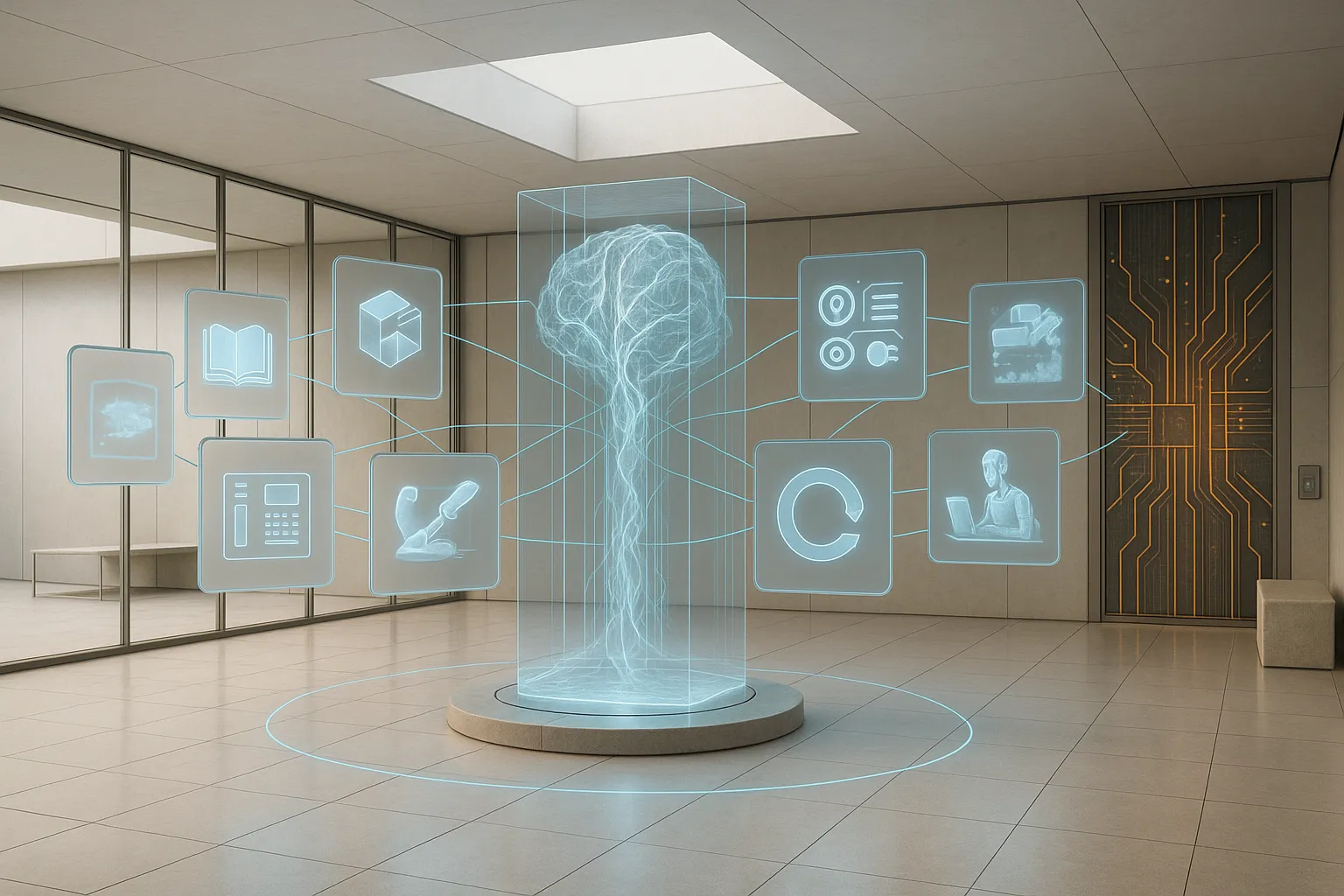💡 TL;DR - The 30 Seconds Version
🧠 LLMs now handle billions of parameters—GPT-4 has over 1 trillion, making it 1,000x more complex than models from five years ago.
💰 Companies save millions by fine-tuning existing models (costs thousands) instead of training from scratch (costs millions).
🎯 85% of generative AI projects fail because companies don't use their own data—they rely on generic models that give generic results.
🤖 AI agents will work autonomously by mid-2025, with 65% of executives planning integration that could boost productivity by 40%.
⚠️ Hallucinations happen in 15-20% of factual queries, but RAG systems cut this to under 5% by checking external databases.
🚀 Multimodal AI processes text, images, audio, and video together—one model can now see your product photo and write your entire marketing campaign.
Remember when AI meant clunky chatbots that couldn't understand basic questions? Those days are gone. Today's generative AI creates human-like text, photorealistic images, and even complex code. But beneath the surface of ChatGPT and DALL-E lies a web of concepts that most people don't understand.
If you want to grasp where AI is heading—and why it matters for your career, business, or daily life—you need to understand these building blocks. Here are the 10 key concepts that define generative AI today.
1. Large Language Models: The Brains Behind the Operation
An LLM is a vast natural language processing model, typically trained on terabytes of data and defined by millions to billions of parameters. Think of them as pattern-recognition engines on steroids. They read massive amounts of text and learn to predict what comes next.
These models don't "understand" language the way humans do. Instead, they master statistical relationships between words. When you type a question into ChatGPT, it calculates the most likely helpful response based on patterns it learned from billions of web pages, books, and articles.
The transformer architecture makes this possible. Its attention mechanism lets the model weigh which words matter most in any given context. That's why LLMs can maintain coherent conversations and remember what you said five messages ago.
2. Foundation Models: One Model, Many Uses
Here's where things get interesting. A foundation model is a large AI model trained on massive and diverse datasets that learns general patterns and representations. Companies no longer need to build separate AI systems for each task.
Instead, they take a foundation model and adapt it. Want a customer service bot? Fine-tune GPT-4. Need a code reviewer? Same model, different training. This flexibility has slashed development costs and democratized AI access.
The economics are compelling. Training a foundation model costs millions, but adapting it for specific uses costs thousands. That's why startups can now compete with tech giants in AI applications.
3. Multimodal AI: Beyond Text
Text was just the beginning. Multimodal AI processes information from text, images, audio and video. These systems don't just read—they see, hear, and synthesize information across formats.
Imagine uploading a product photo and getting back a complete marketing campaign: ad copy, social media posts, and video scripts. Or feeding financial charts into an AI that explains market trends in plain English. That's multimodal AI at work.
In financial services, this could involve analyzing market commentary videos and considering non-verbal cues, like tone of voice and facial expressions. The technology reads between the lines in ways previous AI couldn't.
4. Diffusion Models: The Artists of AI
While LLMs conquered text, diffusion models mastered images. These models gradually add noise to an image and then learn to reverse this process through denoising. It sounds simple, but the results are extraordinary.
DALL-E, Midjourney, and Stable Diffusion can create photorealistic images from text descriptions. Marketing teams generate custom visuals in seconds. Architects visualize buildings before breaking ground. Artists explore styles they never imagined.
The quality keeps improving. Early AI art looked synthetic. Today's outputs fool professional photographers. Tomorrow's might be indistinguishable from reality.
5. The Art and Science of Prompt Engineering
Here's a secret: getting good results from AI is a skill. Prompt engineering entails designing, refining, and optimizing user inputs to guide the model toward desired outputs.
Bad prompt: "Write about dogs." Good prompt: "Write a 200-word guide for first-time dog owners focusing on training basics, essential supplies, and common mistakes to avoid."
The difference? Specificity. Clear goals. Context. Professional prompt engineers now command six-figure salaries because they know how to extract maximum value from AI systems.
6. RAG: Keeping AI Grounded in Reality
LLMs have a dirty secret: they make things up. Hallucinations occur when a model generates content that is not grounded in the training data or any factual source. Ask about a fictional historical event, and they might confidently describe something that never happened.
Enter Retrieval Augmented Generation (RAG). RAG systems incorporate an external document base accessed via an information retrieval mechanism. Before answering, the AI searches relevant databases for facts.
Think of RAG as giving AI a library card. Instead of relying on memory, it checks sources. Customer service bots access product manuals. Legal AI consults case law. Medical systems reference peer-reviewed studies.
7. Fine-tuning vs. Training from Scratch
Building AI models involves two paths. Model pre-training involves training the model from scratch on massive and diverse datasets. This takes months and costs millions.
Model fine-tuning is the process of taking a pre-trained model and exposing it to a smaller, more domain-specific dataset. A few days and thousands of dollars later, you have a specialized AI.
Most businesses choose fine-tuning. Why reinvent the wheel when you can customize an existing one? A law firm fine-tunes GPT-4 on legal documents. A hospital adapts it for medical records. Same foundation, different expertise.
8. Context Windows: The Memory Problem
AI has alzheimer's. Models have fixed context length limitations, which limit how much input they can process in one interaction. Early models forgot conversations after 2,000 words. Today's handle 100,000 or more.
But longer isn't always better. Processing massive contexts slows responses and increases costs. The art lies in balancing comprehensiveness with efficiency. Too little context yields generic answers. Too much overwhelms the system.
Smart developers use techniques like summarization and selective memory. They teach AI what to remember and what to forget.
The idea behind agentic AI is that enterprise agents can function autonomously without requiring human intervention. These aren't just chatbots—they're digital workers.
These AI agents will analyze data across multiple systems of record and automate routine workflows. Picture an AI that monitors your inventory, predicts shortages, orders supplies, and negotiates prices. All while you sleep.
One global study highlights that by mid-2025, more than 65 percent of executives expect to have integrated AI agents into their business functions. The productivity gains could be massive.
10. The Hallucination Problem
Nothing undermines trust like confident lies. When a model generates content that sounds plausible but could be factually incorrect or even nonsensical, it's hallucinating.
Why does this happen? AI predicts likely word sequences. Sometimes "likely" isn't "true." An AI might invent citations, quote non-existent studies, or describe imaginary products.
Solutions exist. RAG systems ground responses in real data. Human reviewers catch errors. Uncertainty indicators flag low-confidence answers. But the problem persists, making human oversight essential for critical applications.
The Data Gold Rush
Looking ahead, every company's data is their gold mine. Generic AI gives generic results. But AI trained on your data? That's competitive advantage.
85% of generative AI projects haven't gone live yet, mainly because businesses aren't utilizing their data effectively. The winners will be companies that unlock their data's potential.
Why this matters:
- AI literacy is the new computer literacy. Understanding these concepts helps you evaluate AI tools, spot opportunities, and avoid pitfalls. You don't need to code, but you need to know what's possible.
- The integration phase is beginning. We've moved past "wow, AI can write!" to "how do we make AI work for us?" 97% of CEOs expect a material impact from the technology. Companies that understand these building blocks will capture that value. Those that don't will watch competitors zoom past.
❓ Frequently Asked Questions
Q: How much does it cost to train a foundation model versus fine-tuning one?
A: Training a foundation model from scratch costs millions of dollars and takes months. Fine-tuning an existing model costs thousands of dollars and takes days or weeks. That's why most businesses choose fine-tuning—it's 100 to 1,000 times cheaper.
Q: What's the actual size difference between early AI models and today's LLMs?
A: Early language models had millions of parameters. GPT-3 has 175 billion parameters. GPT-4 reportedly has over 1 trillion. That's a 1,000-fold increase in complexity, which explains why today's AI can handle tasks that seemed impossible five years ago.
Q: How often do AI models hallucinate, and can we stop it completely?
A: Studies show LLMs hallucinate in 15-20% of factual queries. We can't eliminate hallucinations entirely—it's inherent to how these models work. But RAG systems reduce error rates to under 5% by grounding responses in verified databases.
Q: What exactly is a parameter in an AI model?
A: Parameters are the adjustable weights that determine how the model processes information. Think of them as millions of tiny dials the AI adjusts during training. More parameters mean the model can learn more complex patterns, but also requires more computing power.
Q: How much data do these models actually train on?
A: LLMs train on terabytes of text data—equivalent to millions of books. GPT-3 trained on 570GB of text. For comparison, the entire English Wikipedia is about 20GB. These models read more text during training than a human could read in thousands of lifetimes.
Q: Why do only 15% of generative AI projects go live?
A: According to Databricks CEO Ali Ghodsi, 85% of projects fail because companies don't use their data effectively. They rely on generic models instead of customizing AI with their proprietary information. Success requires turning company data into training data—a step most organizations skip.
Q: What's the salary range for prompt engineers?
A: Prompt engineers earn $100,000 to $300,000 annually, with some positions at major tech companies exceeding $350,000. The field is so new that demand far exceeds supply. Companies pay premium rates for people who can extract maximum value from AI systems.
Q: How long can AI "remember" a conversation now?
A: Context windows have grown from 2,000 tokens (about 1,500 words) in early models to over 100,000 tokens in current systems. Claude can handle 200,000 tokens—roughly a 500-page book. But longer contexts mean slower, more expensive responses.








